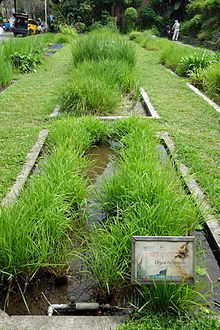Oryza rufipogon is a species of flowering plant in the family Poaceae.[2][3] It is known as brownbeard rice[4], wild rice[5], and red rice[5].
| Oryza rufipogon | |
|---|---|

| |
| Scientific classification | |
| Kingdom: | Plantae |
| Clade: | Tracheophytes |
| Clade: | Angiosperms |
| Clade: | Monocots |
| Clade: | Commelinids |
| Order: | Poales |
| Family: | Poaceae |
| Genus: | Oryza |
| Species: | O. rufipogon
|
| Binomial name | |
| Oryza rufipogon | |

| |
| The range of Oryza rufipogon. | |
| Synonyms[2] | |
| |
It is native to East-, Southeast- and South- Asia. It has a close evolutionary relation to Oryza sativa, the plant grown as a major rice food crop throughout the world. Both have an AA genome.[6]
Invasive species edit
Oryza rufipogon is an invasive species and listed as a 'noxious weed' by the United States,[7] and also listed as a noxious weed in Alabama, California, Florida, Massachusetts, Minnesota, North Carolina, Oregon, South Carolina, and Vermont. According to the NAPPO (North American Plant Protection Organization), O. rufipogon blends in with cultivated O. sativa so well that it cannot be detected. In this position it competes with the cultivated rice and uses valuable fertilizer and space. O. rufipogon sheds most of its seeds before the harvest, therefore contributing little to the overall yield. In addition, the rice grains produced by the plant are not eaten by consumers, who see it as a strange foreign particle in otherwise white rice.[8]
Genetics edit
Selection edit
As with a great many plants and animals, O. rufipogon has a positive correlation between effective population size and magnitude of selection pressure. O. r. having an EPS of ~140,000, it clusters with others of about the same EPS, and has 78% of its amino acid sites under selection.[9]
Precious germplasm edit
In India, the Pallikaranai marshland contains the wild rice O. rufipogon, described by the Sálim Ali Centre for Ornithology and Natural History (SACON) as a "precious germplasm."[10]
Domestication edit
Dai et al., 2012 discover LHD1, an allele of DTH8/Ghd8.[11] Dai also finds LHD1 produces the late heading O. rufipogon phenotype.[11] This is one of the traits bred out during O. sativa domestication.[11]
See also edit
References edit
- ^ Watve, A.; Phillips, J.; Yang, L. (2017). "Oryza rufipogon". IUCN Red List of Threatened Species. 2017: e.T176902A61524992. doi:10.2305/IUCN.UK.2017-3.RLTS.T176902A61524992.en. Retrieved 19 November 2021.
- ^ a b "Oryza rufipogon Griff". Plants of the World Online. The Trustees of the Royal Botanic Gardens, Kew. n.d. Retrieved May 13, 2024.
- ^ "Oryza rufipogon Griff". Catalogue of Life. Species 2000. n.d. Retrieved May 13, 2024.
- ^ USDA, NRCS (n.d.). "Oryza rufipogon". The PLANTS Database (plants.usda.gov). Greensboro, North Carolina: National Plant Data Team. Retrieved 25 July 2015.
- ^ a b "Oryza rufipogon". Germplasm Resources Information Network. Agricultural Research Service, United States Department of Agriculture. Retrieved 12 January 2018.
- ^ Stein, Joshua C.; Yu, Yeisoo; Copetti, Dario; Zwickl, Derrick J.; Zhang, Li; Zhang, Chengjun; Chougule, Kapeel; Gao, Dongying; Iwata, Aiko; Goicoechea, Jose Luis; Wei, Sharon; Wang, Jun; Liao, Yi; Wang, Muhua; Jacquemin, Julie; Becker, Claude; Kudrna, Dave; Zhang, Jianwei; Londono, Carlos E. M.; Song, Xiang; Lee, Seunghee; Sanchez, Paul; Zuccolo, Andrea; Ammiraju, Jetty S. S.; Talag, Jayson; Danowitz, Ann; Rivera, Luis F.; Gschwend, Andrea R.; Noutsos, Christos; Wu, Cheng-chieh; Kao, Shu-min; Zeng, Jhih-wun; Wei, Fu-jin; Zhao, Qiang; Feng, Qi; El Baidouri, Moaine; Carpentier, Marie-Christine; Lasserre, Eric; Cooke, Richard; Rosa Farias, Daniel da; da Maia, Luciano Carlos; dos Santos, Railson S.; Nyberg, Kevin G.; McNally, Kenneth L.; Mauleon, Ramil; Alexandrov, Nickolai; Schmutz, Jeremy; Flowers, Dave; Fan, Chuanzhu; Weigel, Detlef; Jena, Kshirod K.; Wicker, Thomas; Chen, Mingsheng; Han, Bin; Henry, Robert; Hsing, Yue-ie C.; Kurata, Nori; de Oliveira, Antonio Costa; Panaud, Olivier; Jackson, Scott A.; Machado, Carlos A.; Sanderson, Michael J.; Long, Manyuan; Ware, Doreen; Wing, Rod A. (22 January 2018). "Genomes of 13 domesticated and wild rice relatives highlight genetic conservation, turnover and innovation across the genus Oryza". Nature Genetics. 50 (2): 285–296. doi:10.1038/s41588-018-0040-0. PMID 29358651.
- ^ Plant Protection and Quarantine. 2006. Federal noxious weed list (24 May 2006). USDA Animal and Plant Health Inspection Service. Washington, DC. 2pp. http://plants.usda.gov/java/profile?symbol=ORRU
- ^ NAPPO ([[North American Plant Protection Organization ]]) - PRA / Grains Panel Pest Fact Sheet - Oryza rufipogon Griff. June / 2003, http://www.nappo.org/PRA-sheets/Oryzarufipogon.pdf Archived 2007-07-30 at the Wayback Machine
- ^ Hough, Josh; Williamson, Robert J.; Wright, Stephen I. (2013-11-23). "Patterns of Selection in Plant Genomes". Annual Review of Ecology, Evolution, and Systematics. 44 (1). Annual Reviews: 31–49. doi:10.1146/annurev-ecolsys-110512-135851. ISSN 1543-592X.
- ^ The Hindu/Vanishing Wetlands- 09 March 2005, http://www.hindu.com/2005/03/09/stories/2005030903421000.htm
- ^ a b c Liang, Yameng; Liu, Hai-Jun; Yan, Jianbing; Tian, Feng (2021). "Natural Variation in Crops: Realized Understanding, Continuing Promise". Annual Review of Plant Biology. 72 (1). Annual Reviews: 357–385. doi:10.1146/annurev-arplant-080720-090632. ISSN 1543-5008. PMID 33481630. S2CID 231688091.
